
The Talyllyn Railway is a narrow-gauge railway in Wales running for 7+1⁄4 miles (12 km) from Tywyn on the Mid-Wales coast to Nant Gwernol near the village of Abergynolwyn. The line was opened in 1865 to carry slate from the quarries at Bryn Eglwys to Tywyn, and was the first narrow gauge railway in Britain authorised by Act of Parliament to carry passengers using steam haulage. Despite severe underinvestment, the line remained open, and in 1951 it became the first railway in the world to be preserved as a heritage railway by volunteers.

Streatham Hill railway station is one of three stations serving the district of Streatham, in the London Borough of Lambeth. It is 5 miles 57 chains (9.2 km) measured from London Victoria. The wooden station building at street level faces the busy Streatham High Road (A23) at the junction with Leigham Court Road. Services are operated by Southern.
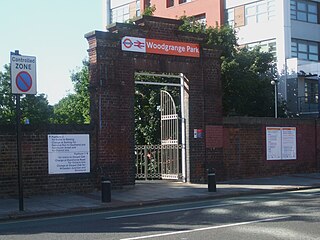
Woodgrange Park is a railway station on Romford Road in Manor Park in the London Borough of Newham, east London. It is served by the Suffragette line of the London Overground. It is located 12 miles 1 chain (19.3 km) down the line from Gospel Oak; it lies in Travelcard Zones 3 and 4. It has only limited station buildings and facilities.
The South Staffordshire line is a partially mothballed and active former mainline that connects Burton-upon-Trent to Lichfield in Staffordshire and formerly then to the West Midlands towns of Walsall, Wednesbury, Dudley and Stourbridge. However, Dudley and Stourbridge were already joined to the Oxford, Worcester and Wolverhampton Railway's (OW&WR) line just north of Dudley Station. It in essence, continued to Stourbridge along with Wednesbury and Walsall.
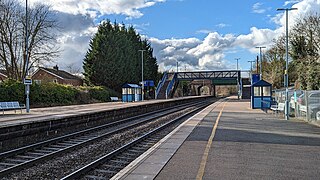
Hatton railway station takes the name of the village of Hatton in Warwickshire, England, although it is about 1 mile (1.6 km) from the village. It is situated in the linear settlement of the same name, that evolved around the station, mainly in the 1950s and 1960s. Other close settlements are Little Shrewley and Shrewley. The station is managed by Chiltern Railways.
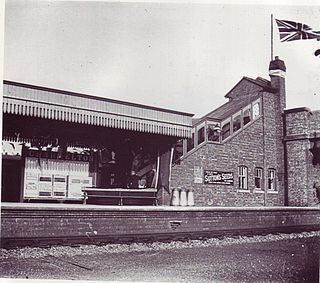
Charwelton railway station was a station at Charwelton in Northamptonshire on the former Great Central Railway main line, the last main line to be built from the Northern England to London. The station opened with the line on 15 March 1899.

Morven is a small village about 7 kilometres east of Culcairn in the eastern Riverina district of New South Wales, Australia. At the 2021 census, Morven has a population of 125 people.
There are 22 disused railway stations on the Bristol to Exeter line between Bristol Temple Meads and Exeter St Davids. The line was completed in 1844 at which time the temporary terminus at Beambridge was closed. The most recent closure was Tiverton Junction which was replaced by a new station} on a different site in 1986. 12 of the disused stations have structures that can still be seen from passing trains.

The Forest of Dean Railway was a railway company operating in Gloucestershire, England. It was formed in 1826 when the moribund Bullo Pill Railway and a connected private railway failed, and they were purchased by the new company. At this stage it was a horse-drawn plateway, charging a toll for private hauliers to use it with horse traction. The traffic was chiefly minerals from the Forest of Dean, in the Whimsey and Churchway areas, near modern-day Cinderford, for onward conveyance from Bullo Pill at first, and later by the Great Western Railway.
The Coleford Railway was a railway company that constructed a short railway from near Monmouth to Coleford, close to the Forest of Dean. The company was sponsored by the Great Western Railway. It was built on part of the course of the Monmouth Railway, a horse-operated plateway, and it was intended that its primary business would be the conveyance of minerals and forest products from the Forest of Dean.

The Ross and Monmouth Railway was a standard gauge railway of 13 miles (21 km) which ran between Ross-on-Wye, in Herefordshire, England and Monmouth, Wales.
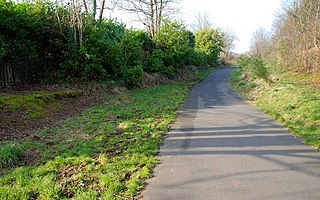
Neill's Hill railway station is a disused railway station / halt on the main line of the Belfast and County Down Railway. It ran from Queen's Quay, Belfast south to Newcastle, County Down in Northern Ireland.

Forest Hill is a rural town and locality in the Lockyer Valley Region, Queensland, Australia. In the 2021 census, the locality of Forest Hill had a population of 935 people.
Tuckanarra is a small town in the Shire of Cue in the Murchison region of Western Australia. The town is located between Cue and Meekatharra along the Great Northern Highway in the Mid West region of Western Australia.

The Mitcheldean Road and Forest of Dean Junction Railway was an independent railway company incorporated in 1871, to provide a northerly outlet for iron ore and coal products from the Cinderford and Whimsey area in the Forest of Dean, to the Hereford, Ross and Gloucester Railway line; mineral traffic to industrial centres in South Wales and the Midlands was foreseen.
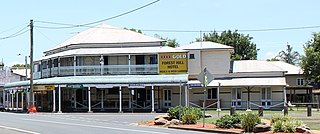
Forest Hill Hotel is a heritage-listed hotel at 38 William Street, Forest Hill, Lockyer Valley Region, Queensland, Australia. It was built in 1898. It is also known as Station Hotel. It was added to the Queensland Heritage Register on 21 October 1992.

Lockyer Hotel is a heritage-listed hotel at Victoria Street, Forest Hill, Lockyer Valley Region, Queensland, Australia. It was built from 1906 to 1970s. It was added to the Queensland Heritage Register on 21 October 1992.

Queensland National Bank is a heritage-listed bank at 3 Victoria Street, Forest Hill, Lockyer Valley Region, Queensland, Australia. It was built c. 1909. It was added to the Queensland Heritage Register on 21 October 1992.
Ilbilbie is a rural town and coastal locality in the Isaac Region, Queensland, Australia. In the 2021 census, the locality of Ilbilbie had a population of 385 people.













